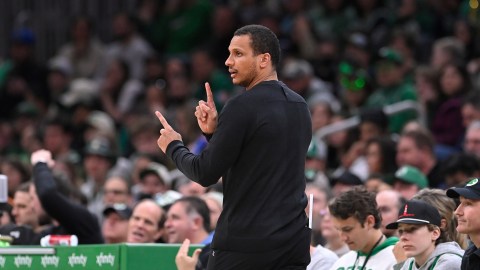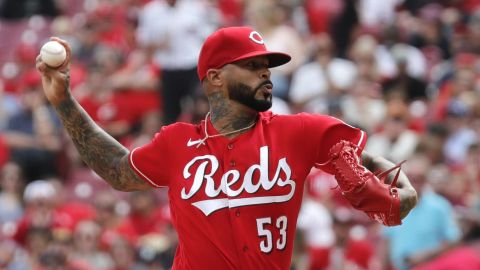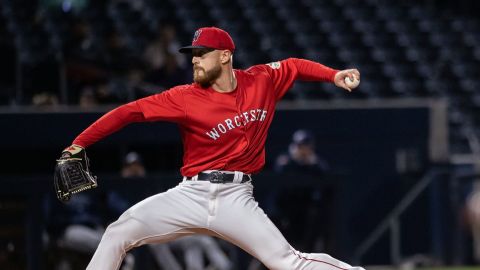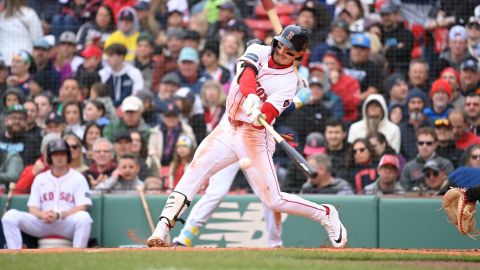 Felix Doubront‘s starts felt like Groundhog Day throughout much of 2012. Like most of the Red Sox’ pitchers, he tended to let the big inning get to him, but at times the young left-hander looked brilliant, using his vast repertoire, mid-90s velocity and devastating movement to great effect.
Felix Doubront‘s starts felt like Groundhog Day throughout much of 2012. Like most of the Red Sox’ pitchers, he tended to let the big inning get to him, but at times the young left-hander looked brilliant, using his vast repertoire, mid-90s velocity and devastating movement to great effect.
But no matter how well or how poorly he was pitching, by the fifth inning you’d look down at the box score and, invariably, the now-25-year-old’s pitch count would suggest he wasn’t long for the game. That clearly needs to change if Doubront hopes to take the next step in his evolution as a pitcher. His stuff suggests that he has the potential to be as dominant as any pitcher in baseball. But pure stuff and potential don’t matter much if you can’t command it.
Throughout the year, most of Doubront’s struggles were attributed to his green status. However, according to some statistical heavy lifting on the part of The Providence Journal’s Tim Britton, it’s just patently false that pitchers intrinsically improve their command and pitch efficiency as they age, which doesn’t necessarily bode well for Doubront.
On the season, Doubront threw 2,868 pitches over the course of 161 innings, which works out to an average of 17.8 pitches per inning — just beating out Tim Lincecum for baseball’s worst rate among pitchers with at least 160 innings pitched on the season. That’s a mark that obviously needs to improve, but is it a function of maturity? Ask the coaches around Doubront last season, and that’s exactly what they’ll say.
“It’s just a learning process,” Red Sox pitching coach Randy Niemann said. “He’ll get it. He’s young in his development. The stuff is there — it’s just a matter of doing it. Pretty soon, those 18- to 20-pitch innings turn into 10- to 12-pitch innings, and now we’re deeper into the game with a better chance to win.”
“When he understands how to attack certain hitters, it’s going to be easier to throw less pitches and get more strikeouts and less walks,” echoed former manager Bobby Valentine.
But here’s the problem: There’s no statistical evidence that suggests a correlation between experience and pitch efficiency. No one is expecting Doubront to ever develop Cliff Lee‘s aversion to free passes, but everyone agrees he needs to learn to consistently work beyond the sixth inning to become the pitcher the Red Sox are counting on him to be.
To quote Britton’s article:
Contrary to popular belief, efficiency isn’t necessarily a learned skill. On the whole, veteran pitchers throw about the same number of pitches per inning as young pitchers. In 2012, 107 different pitchers have thrown at least 120 innings as starters, ranging from 21-year-old Jordan Lyles to 39-year-old Bartolo Colon. Pretty much regardless of age, they throw between 15.5 and 16.5 pitches per inning.
Pitchers 23 or younger average 16.0 pitches per inning, which is actually better than pitchers in their purported primes at 27-29 (16.2 per inning).
Furthermore, pitchers who have years like Doubront’s 2012 — years with more than 150 innings and more than 17.9 pitches per inning — haven’t shown a predilection for improvement with age. In fact, most of them run into problems. Pitchers such as Scott Kazmir and Jonathan Sanchez have not shown improved efficiency with age.
Britton goes on to note that Doubront averages more than four pitches per plate appearance, and he ends at-bats in three pitches or fewer just 40 percent of the time. Additionally, getting ahead in the count is not as much of an advantage as it should be, as Doubront has walked 9 percent of batters he’s faced after going up 1-2 in the count, which is just a tick below the 10.3 percent walk rate he has in all situations.
Does this mean that Doubront is indeed condemned to the future of fellow failed lefties Kazmir and Sanchez? Well, not necessarily. Kazmir actually showed improved pitch efficiency later in his time with the Rays and early with the Angels, but by that point he was also compensating for shoulder injuries, which sapped much of his velocity. Sanchez, meanwhile, appeared to a be bit of a head case who may be closer to Steve Blass than a pitcher who’s simply nibbling at the corners too much.
More to the point, Doubront gave some huge reasons for optimism to close the 2012 season. While many voices suggested shutting down the southpaw due to the fact that his innings workload had already surpassed any in his professional career, Doubront lobbied to stay in the rotation — a decision that paid off. In his last two starts, Doubront threw seven innings in each, walking just three over those 14 frames while striking out 21. And, most importantly, Doubront averaged 15.6 pitches per inning, showing noticeable improvement in his willingness or ability to attack the strike zone.
Nonetheless, Doubront’s late-season success is a reminder that the facets of the game where he needs improvement may not be a part of normal development. Rather, they will take real, tangible changes in his approach or mechanics to get better. For the Red Sox to contend in 2013, the rotation will need a fair amount of in-house improvement, and that starts with Doubront, who, as a sophomore, is expected to have not reached his ceiling yet.
By all accounts, Doubront knows the results he needs to change in order to evolve as a pitcher — he’s consistently acknowledged his efficiency shortcomings in interviews all year. But does he know what specific changes to make to his game, and does he have the mental discipline to make possibly drastic changes to an approach he likely hasn’t had to adjust in years?
The Red Sox are counting on it.



